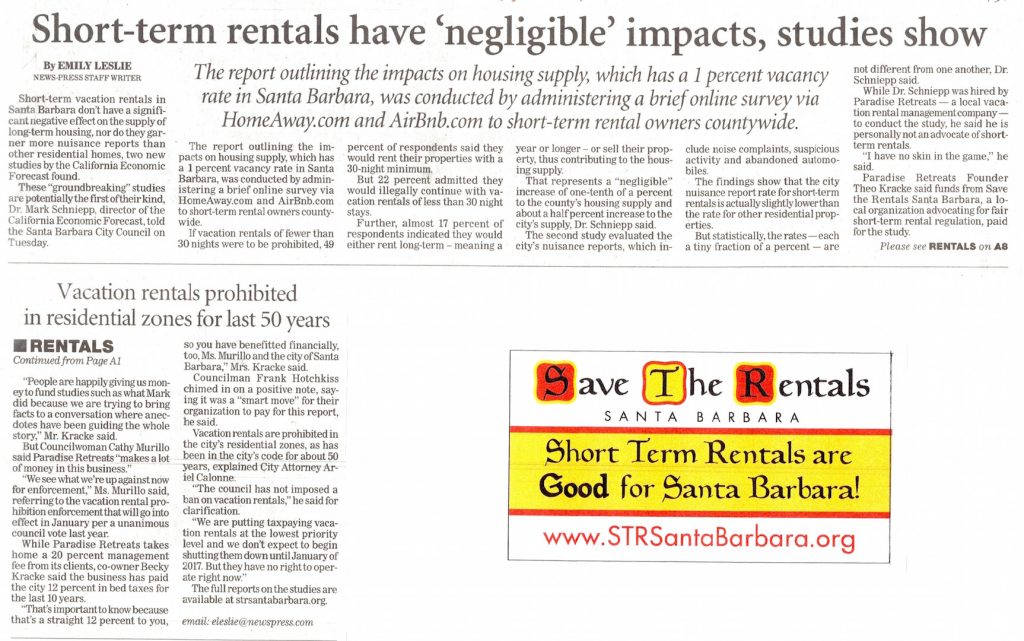FOR IMMEDIATE RELEASE
 On November 30, 2016, Travis C. Logue and Jason W. Wansor, attorneys for the Santa Barbara law firm of Rogers, Sheffield & Campbell, LLP, filed a Petition for Writ of Mandate and Complaint for Civil Penalties for Violation of the California Coastal Act against the City of Santa Barbara (the “City”).
On November 30, 2016, Travis C. Logue and Jason W. Wansor, attorneys for the Santa Barbara law firm of Rogers, Sheffield & Campbell, LLP, filed a Petition for Writ of Mandate and Complaint for Civil Penalties for Violation of the California Coastal Act against the City of Santa Barbara (the “City”).
The suit stems from the City’s decision to ban short-term vacation rentals (STVRs). The prohibition will apply to all STVR properties beginning January 1, 2017.
The petition was filed on behalf of the firm’s client, Theo Kracke, a 35-year resident of Santa Barbara, and proprietor of Paradise Retreats World Class Vacation Rentals. Mr. Kracke has been engaged in operating, managing and servicing vacation rentals in and around the City since 2006, many of which are located within the City’s Coastal Zone, as defined under the Coastal Act.
The California Constitution and the Coastal Act require coastal access to be protected, provided, and maximized for all. STVRs serve as an alternate form of visitor-serving accommodations within the Coastal Zone, that provide a lower-cost alternative to renting hotel or motel rooms for families from diverse demographic sectors and range of incomes to enjoy unique local coastal resources. In recognizing these benefits, the Coastal Commission has urged local municipalities to regulate rather than outlaw STVRs. The suit alleges the City’s prohibition against STVRs contravenes both State and local law. The ban violates the City’s certified Local Coastal Plan (“LCP”) and Chapter 28.44 of the Santa Barbara Municipal Code, which was established for the purposes of implementing the Coastal Act and ensuring all public and private development in the City’s Coastal Zone is consistent thereto.
In 2014, the California Coastal Commission awarded a $123,000 grant to the City to update its LCP and address “the very old LCP policies and development standards.” Yet since that time, the City has neglected to take any action towards an update. In light of the ban, the City missed a key opportunity to act in a thoughtful manner and apply the grant award to hold public workshops, analyze the impact of STVRs from diverse perspectives, seek and obtain Commission input, and employ reasonable and balanced regulation designed to address the primary concerns of neighborhood compatibility and diminished affordable housing stock while allowing for regulated STVRs in residential and other zoning districts.
Mr. Kracke is seeking a writ of mandate requiring the City to either (i) submit and process a Coastal Development Permit; or (ii) amend its LCP and pursue certification by the Commission.
###
Contact: Theo Kracke
Phone: 805-275-1851
Email: theo@paradiseretreats.com
To read, print and/or download the full text of the complaint, please see the PDF link available at the Rogers, Sheffield & Campbell, LLP web site.
01 Dec / 2016
Lawsuit Challenges Vacation-Rental Crackdown
By Keith Hamm, Santa Barbara Independent
The City of Santa Barbara’s escalating crackdown on short-term vacation rentals has experienced plenty of expected backlash, the latest of which claims in court that the city’s position violates California’s formidable Coastal Act, a 40-year-old law designed to balance development pressures along the coast with conservation efforts and public access. The lawsuit — filed this week by Theo Kracke, owner of Paradise Retreats, which manages 27 short-term rentals within city limits — is buoyed by state law requiring relatively affordable overnight lodging along the coast. According to the suit, “[Short-term vacation rentals] serve as a lower cost alternative to renting hotel or motel rooms for families and small groups from diverse demographic sectors and incomes to enjoy coastal access.”
See the full article at Independent.com.
24 Nov / 2016
The Hart of Santa Barbara’s Short-Term Rental Ban
Connecting the Dots Between Hotels and City Hall
This editorial originally appeared in the Santa Barbara Independent on November 23, 2016.
James Fenkner writes this opinion piece after his experiences owning a condo in Santa Barbara’s R-4 hotel zone. An investigative financial analyst who moved from Russia to Santa Barbara in 2009, Fenkner has also rented out his home during the summer occasionally, which has allowed him to travel with his wife and children. Both properties, which he owns with his wife, have been fully licensed and paid taxes. The majority of their renters have been families with children.
Starting January 1, 2017, all short-term vacation rentals in the City of Santa Barbara will be unlawful. The mom and pop or, as is often the case, grandma and grandpa owners who continue to rent out even one room for less than 30 days will face the city’s wrath. Miscreants will be heavily fined. For those who ask forgiveness, a magnanimous City Council has decided they may pay a lesser fine in exchange for waiving their First and Fourth Amendment rights and swearing to never rent less than 30 days again. Life will be harder for those who resist. If Grandma ignores warnings to cease and desist, the city may search her home and seize evidence of illicit conduct — which would presumably include misplaced family photos, packed suitcases, or a tourist map of State Street.
To fund this war on small-time hospitality, the city has summoned awesome resources. The city’s attorney has been apportioned an additional $150,000 to his budget and will get three new employees. Their mission: to scour the Internet in search of a public enemy so addicted to new friendships, ambassadorial pride, home beautification, and the thrill of making ends meet that they occasionally rent out their own homes for less than 30 days. Already the city attorney has sprung into action and subpoenaed 44 websites that advertised short-term rental sites.
There’s something un-American about the vociferous prosecution of residents for what they do in their homes. Rather than update a decades old municipal code to properly recognize and regulate vacation rentals, the city has chosen to criminalize what for years has been a licensed, tax-paying practice. Enforcement will have to compete with the city’s other core priorities — police, fire, parks, libraries, public works, homeless shelters, under-funded pensions, as well as the weeding out of city waste and corruption.
Why would the city want to do this? Proponents of the ban weave a deeply seductive tale based on Santa Barbara’s housing shortage. They’ll tell you that those loud, obnoxious tourists are parking on your street, sleeping in your bed, deflowering your fair city, and having a far better time doing it than you’ll ever have, all at your expense. Never mind that these urban myths have been thoroughly debunked. The truth lies elsewhere. To find it, follow the money.
Dug in at the money trailhead you’ll find the city’s hotels. By eliminating competition from the hundreds of short-term vacation rentals, Santa Barbara’s hotels snatched control of a valuable monopoly to lodge any and all guests staying less than 30 days. Beginning in 2017, well over $20 million a year in revenue, that was previously shared amongst short-term vacation rentals owners, will flow to the hotels. And this valuable, corporate handout comes just in the nick of time. The long derelict Californian Hotel is in the process of being redeveloped, renamed, and vastly expanded as the 123 room La Entrada de Santa Barbara, slated to open its doors in early 2017. Absent short-term rental competition, demand for all hotel rooms should easily absorb this increased supply, and then some. To understand how one business clique came to eliminate competition from short-term rentals and monopolize all lodging choices, follow the money.
Look no further than Santa Barbara City Councilmember Gregg Hart, the undisputed force behind the city’s ban of short-term rentals, and the money trail appears to run dry. Or does it? Like other City Council members, Hart is required by state law to file an annual ethics Form 700 disclosing his outside financial interests. What makes Hart’s disclosure forms so remarkable is what precious little he discloses. In fact, Hart disclosed less information than any other Santa Barbara councilperson on record, ever.
During Hart’s 2013 campaign, he boasted of running a “small family business”. Does he still own it, did he sell it, what ever happened to the money? All Hart’s personal investment disclosures are completely blank. As the City Council’s sole representative to both Downtown Santa Barbara and Visit Santa Barbara (a marketing group funded by the largest hotels), Hart regularly meets with the city’s well-heeled entertainment and hospitality interests. Could it be that over the past three years no one hosted the affable Hart at a single event, picked up his tab, or sent him a Christmas basket?
There is one other minor detail missing: Hart’s other full-time job. Nowhere on the city’s ethics forms does Hart make reference to his $100,000/year-plus-benefits public relations job at Santa Barbara County Association of Governments, a transportation bureaucracy partially funded by Measure A that has a hand in everything that moves along the central coast. Even if you have trouble comprehending why an intergovernmental bureaucracy needs such an expensive PR employee to primarily prepare “press releases and marketing material,” don’t give up now. Follow the money.
Hotel owners, managers, investors, and even hotel consultants have all openly contributed to Hart’s 2013 city council campaign. The only hotel-related group that did not is the one Hart pretends are his core constituents, the hotel workers. Depending on how it is sliced, hotel and development-related monies account for over $30,000 or one out of very four dollars of Hart’s record 2013 campaign funding. In all fairness, Frank Hotchkiss, to a lesser degree, and Bendy White also received money in 2013 from some of these same hotel/developer interests. What sets Hart apart is his lobbyist enthusiasm in presenting the hotel owners’ side of the vacation rental story, which is what I heard when I originally asked him about the ordinance. To find the genesis of this errant affair, follow the money.
The Hart and Hotel romance was consummated nearly two decades ago during Hart’s first two terms on City Council. Public campaign records from this era have been destroyed by the city clerk’s office, but, thankfully, private newspaper archives somehow survived. What happens next may be pure coincidence, but it smells fishy: Hart, who discloses no investments, claims to have made a $10,000 interest-free loan to his own 2013 campaign around the time that La Entrada de Santa Barbara was passing the city’s Historic Landmarks review but before millions of development dollars were put at risk. What is clear is that the $10,000 loan is the only recorded campaign loan outstanding among the entire City Council, and it has not yet been repaid. Future campaign contributions, perhaps from appreciative hoteliers, could enable that $10,000 to slide, like an anonymous hotel key, into Hart’s own back pocket. Stay tuned, and follow the money.
Only an independent investigation, with power of subpoena and enforcement, could clarify the full symbiotic financial relationship between Hart and the hotels. Gauge, if you will, the prevalence of self-dealing within the Santa Barbara City Council by the enthusiasm upon which they proceed. In the meantime, ponder the public good subverted and the public access denied by gifting a small clique of hotels a monopoly to underserve the full diversity of guests who visit our lovely, world-renowned city.
01 Nov / 2016
Let’s Discuss the FACTS Regarding Short Term Rentals
This editorial originally appeared in the Santa Barbara News-Press in October 2016.
We expect our government officials to make balanced decisions in the best public interest, based on actual evidence, not opinions or guesses. Unfortunately, that is not what is happening in the County and City of Santa Barbara in the case of Short Term Rentals (STRs).
Since last year, STRs have been targeted as a significant cause of both our shortage of affordable housing, and the degradation of the quality of our residential neighborhoods.
Let me start with some actual facts.
(NOTE: all of these facts can be confirmed by reading the reports located at www.STRSantaBarbara.org/Reports):
Short Term Rentals represent about 1.7% of the entire housing market in Santa Barbara City and County (there are approximately 2,550 STRs out of 147,368 total housing units).1
STRs are a major source of revenue for the City and County of Santa Barbara, generating about $470 million in overall economic activity, and creating about 5,000 jobs.2
Last year, the City and County collected approximately $2.6 million in STR Transient Occupancy Taxes (TOT) with only a fraction of STRs paying TOT. With fair regulations that require full enrollment by all STRs, the TOT revenues would triple to about $3.6 million per year to the City of Santa Barbara, and quadruple to about $5.6 million per year to the County of Santa Barbara; a total of $9.2 million per year.
STRs provide property owners with a way to generate income to help support the affordability of their home, while also having the ability to enjoy the home throughout the year.
STRs provide important local short-term housing such as temporary housing for workers, professors, families relocating for employment, executive housing, insurance claim temporary housing, housing needed during remodels, and families who come to town for medical procedures.
STRs provide affordable & authentic accommodations for families who cannot afford multiple hotel rooms.
In spite of these benefits, the SB County Planning Commissioners recently recommended that short term rentals be banned in most of the County. This recommendation, when combined with the current enforcement actions approved by the City of Santa Barbara, will devastate this sector of our economy, and will cost many people their jobs.
The decisions to prohibit STRs in residential areas have been based on two allegations which have never been supported by data or formal studies: 1) Housing advocates have alleged that STRs are a significant cause of the shortage of affordable housing. 2) Some neighbors have alleged that STRs are creating excessive nuisances, and that STRs have destroyed the “character” of residential neighborhoods.
These allegations might seem intuitive, until you remember that STRs represent only 1.7% of the total housing stock in Santa Barbara City & County. Because STRs represent such a low percentage of our residential housing, it is physically impossible for such a small percentage of homes to create such a large percentage of problems (however it is not impossible for a small percentage of vocal opponents to create the impression that these problems are enormous).
To add facts to a conversation where opinions and guesses have led the discussion, a respected local consulting firm recently conducted two academic analyses of those allegations:
The first report, The Effect of Short Term Rentals on the Supply of Housing in Santa Barbara City & County, concludes that STRs affect about 1/10th of 1% of the long-term rental housing supply, and are not a significant cause of the shortage of affordable housing. Why? First, the quantity of STRs as a percentage of total housing is very low (about 1.7%). Second, 85% of STRs are used throughout the year by the owner, so they would never be available as long-term rentals. Finally, the median STR home value in Santa Barbara is over $2m, and about 50% of STRs would rent for over $5,000 per month as a long-term rental. These costs disqualify most STRs as housing that could ever be considered “affordable”.1
The second report, The Effect of Short Term Rentals on Neighborhood Nuisance Complaints Along the Central Coast concludes that nuisance report rates for STRs are slightly less (to substantially less depending on the City) than nuisance report rates for all residential properties. Readily available data was collected from San Luis Obispo to Thousand Oaks, and the conclusions of this report are logical and irrefutable.3
The win-win solution is not to prohibit short-term rentals, but rather to regulate them (as both Goleta and Ventura have done).
Save The Rentals Santa Barbara (www.STRSantaBarbara.org) is a group of over 850 supporters committed to the idea that well-managed and well-regulated STRs can be a benefit to our community. We have created an outline that presents the overriding principles that will allow STRs to co-exist within current bylaws and zoning. Please take a minute to understand that there is a balanced solution to this issue by reading our proposal titled A Plan for Fair Regulation of STRs in Santa Barbara.4
As partners who share a passion for the benefits of short term rentals (and who also understand the concerns of neighborhood compatibility & housing supply), we look forward to working with the County & City of Santa Barbara to create a regulatory framework that works in the public interest, and gives certainty to this important part of our local economy.
(Theo Kracke is the leader of Save The Rentals Santa Barbara, an advocacy group promoting the Fair Regulation of Short Term Rentals in Santa Barbara City & County)
Footnotes
1. The Effect of Short Term Rentals on the Supply of Housing in Santa Barbara City & County (www.STRSantaBarbara.org/reports)
2. The Local Economic Impact of Short Term Rentals in Santa Barbara, CA (www.STRSantaBarbara.org/reports)
3. The Effect of Short Term Rentals on Neighborhood Nuisance Complaints Along the Central Coast (www.STRSantaBarbara.org/reports)
4. A Plan for Fair Regulation of STRs in Santa Barbara (www.STRSantaBarbara.org/reports)
The interaction between short-term rentals and the availability of affordable housing units has been a focus of housing policy discussions across the United States. The fundamental question asked in these discussions is: “If short-term rental platforms like Airbnb did not exist, would the owners of those units instead rent those units to long-term renters at affordable rates? If so, how many units are actually lost to short-term rentals?” In Portland, several studies have explored this relationship. To add its data to the discussion, Airbnb asked ECONorthwest to analyze the most current Airbnb entire home listings to provide data and interpretation of the interaction between these listings and housing affordability in the City.
The results of the analysis show that Airbnb’s activities in Portland have minimal, if any, impact on the current affordability crisis.
Click below to view and/or save the full report in PDF format.
Housing Affordability Impacts of AirBnB in Portland PDF | 3.6 MB | Published October 19, 2016
20 Jul / 2016
Group Defends Short-Term Vacation Rentals
By Keith Hamm, Santa Barbara Independent
Continuing its counterattack against Santa Barbara’s opposition to short-term vacation rentals in residential neighborhoods, advocacy group Save the Rentals has released a pair of reports claiming that the impact of short-term rentals on long-term housing and neighborhood tranquility has been overstated.
See the full article at Independent.com.
See also here on Save the Rentals:
Recently Published Studies Prove Negative Effects of Short Term Rentals are Overstated
By Emily Leslie, News-Press Staff Writer
 See the full article at Newspress.com.
See the full article at Newspress.com.
See also here on Save the Rentals:
Recently Published Studies Prove Negative Effects of Short Term Rentals are Overstated
19 Jul / 2016
Recently Published Studies Prove Negative Effects of Short Term Rentals are Overstated
The Effect of Short Term Rentals on Neighborhood Nuisance Complaints Along the Central Coast
This report presents data-supported analysis and conclusions regarding the incidence of nuisance complaints for Short-Term Rentals (STRs) in cities and unincorporated areas along the Central Coast. This study addresses the specific question: Do short-term rentals cause an increase in nuisance complaints in Central Coast cities?
Click below to view and/or save the full report in PDF format.
STR Effect on Neighborhoods Study PDF | 967 kb | Published June 28, 2016
The Effect of Short Term Rentals on The Supply of Housing in Santa Barbara City and County
This report presents data-supported analysis and conclusions regarding the impact of Short-Term Rentals (STRs) on the supply of long-term housing in Santa Barbara City and County.
Click below to view and/or save the full report in PDF format.
STR Effect on Housing Study PDF | 700 kb | Published May 12, 2016
02 Jun / 2016
Short-Term-Rental Crackdown Gains Steam
City Sends 389 Warning Letters to Owners and Operators
By Keith Hamm, Santa Barbara Independent
Tracking down alleged offenders through online research, neighbor complaints, and subpoenaed information from companies that connect vacationers to short-term rentals in Santa Barbara, city zoning enforcement officials recently mailed 389 letters reminding owners and operators that such activity is “unlawful in Santa Barbara unless [it’s permitted and] located in zoning districts which allow hotels, motels, or bed and breakfast inns.” The letters represent the city’s latest effort to get a handle on the proliferation of short-term (fewer than 30 days) rentals — both whole-house and owner-occupied homestay accommodations — within city limits.
See the full article at Independent.com.
By Kiley Smith, Huffington Post
A new study measuring the impact of short-term home rentals in Santa Barbara County, one of California’s top tourism destinations, shows that the industry generates close to $500 million a year locally and creates 5,000 direct and indirect jobs.
The comforts of home on your next Santa Barbara vacation may soon be disappearing. In the summer of 2015, the Santa Barbara city council voted to ban short term vacation rentals, citing potential noise complaints and a shrinking open rental market.
Though heavily opposed by the public, these new ordinances – which go into effect in Q1 2017 – will force a booming industry to almost completely shutter its doors, sacrificing jobs, significant revenue loss, and potentially causing a plummet in real estate home values in the area.
See the full article at HuffingtonPost.com.


 We have several expensive projects underway which need funding.
We have several expensive projects underway which need funding. 


